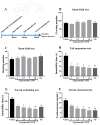Gypenoside XVII, an Active Ingredient from Gynostemma Pentaphyllum, Inhibits C3aR-Associated Synaptic Pruning in Stressed Mice
- PMID: 35745148
- PMCID: PMC9228113
- DOI: 10.3390/nu14122418
Gypenoside XVII, an Active Ingredient from Gynostemma Pentaphyllum, Inhibits C3aR-Associated Synaptic Pruning in Stressed Mice
Abstract
Gynostemma pentaphyllum is a herbal medicine widely used in Asian countries, and its saponin extracts have been shown to possess potent anti-inflammatory effects. Gypenoside XVII, an active ingredient isolated from Gynostemma pentaphyllum, has been found to alleviate the inflammation induced by LPS in the BV2 microglia, according to our preliminary study. This study aims to evaluate whether Gypenoside XVII could attenuate depression-like symptoms in vivo and tries to demonstrate the involvement of the complement regulation in its antidepressant-like effect. The results showed that Gypenoside XVII significantly attenuated depression-like behaviors in the forced swimming test, tail suspension test and sucrose preference test. It also alleviated the acute stress-induced hyperactivity of serum corticosterone levels. Additionally, Gypenoside XVII significantly inhibited the activation of microglia and the expression of C3 in mice exposed to chronic unpredictable mild stress (CUMS). Meanwhile, the activation of C3aR/STAT3 signaling and the expression of proinflammatory cytokines was reversed by Gypenoside XVII. Moreover, CUMS induced excessive synaptic pruning by activating microglia, while Gypenoside XVII restored it in the prefrontal cortex. Our data demonstrated that Gypenoside XVII, the active ingredient of Gynostemma pentaphyllum, produced the antidepressant-like effects in mice, which was mediated by the inhibition of complement C3/C3aR/STAT3/cytokine signaling in the prefrontal cortex.
Keywords: Gypenoside XVII; antidepressant; complement C3; microglia; synaptic pruning.
Conflict of interest statement
The authors declare no conflict of interest.
Figures






Similar articles
-
Gypenoside A from Gynostemma pentaphyllum Attenuates Airway Inflammation and Th2 Cell Activities in a Murine Asthma Model.Int J Mol Sci. 2022 Jul 12;23(14):7699. doi: 10.3390/ijms23147699. Int J Mol Sci. 2022. PMID: 35887041 Free PMC article.
-
Effects of heat-processed Gynostemma pentaphyllum on high-fat diet-fed mice of obesity and functional analysis on network pharmacology and molecular docking strategy.J Ethnopharmacol. 2022 Aug 10;294:115335. doi: 10.1016/j.jep.2022.115335. Epub 2022 May 2. J Ethnopharmacol. 2022. PMID: 35513215
-
Gypenosides reverses depressive behavior via inhibiting hippocampal neuroinflammation.Biomed Pharmacother. 2018 Oct;106:1153-1160. doi: 10.1016/j.biopha.2018.07.040. Epub 2018 Jul 18. Biomed Pharmacother. 2018. PMID: 30119182
-
Triterpenoids from the genus Gynostemma: Chemistry and pharmacological activities.J Ethnopharmacol. 2021 Mar 25;268:113574. doi: 10.1016/j.jep.2020.113574. Epub 2020 Nov 10. J Ethnopharmacol. 2021. PMID: 33186700 Review.
-
Neuroprotective effects of Gypenosides: A review on preclinical studies in neuropsychiatric disorders.Eur J Pharmacol. 2024 Sep 5;978:176766. doi: 10.1016/j.ejphar.2024.176766. Epub 2024 Jun 20. Eur J Pharmacol. 2024. PMID: 38908668 Review.
Cited by
-
Impaired Aggrephagy, Interrupted Vesicular Trafficking, and Cellular Stress, Lead to Protein Aggregation, and Synaptic Dysfunction in Cerebellum of Children and Adults with Idiopathic Autism.Cerebellum. 2025 Aug 8;24(5):140. doi: 10.1007/s12311-025-01880-5. Cerebellum. 2025. PMID: 40779003 Free PMC article.
-
Production of Gypenoside XVII from Ginsenoside Rb1 by Enzymatic Transformation and Their Anti-Inflammatory Activity In Vitro and In Vivo.Molecules. 2023 Oct 9;28(19):7001. doi: 10.3390/molecules28197001. Molecules. 2023. PMID: 37836844 Free PMC article.
-
The therapeutic potential of traditional Chinese medicine in depression: focused on the modulation of neuroplasticity.Front Pharmacol. 2024 Aug 26;15:1426769. doi: 10.3389/fphar.2024.1426769. eCollection 2024. Front Pharmacol. 2024. PMID: 39253375 Free PMC article. Review.
-
Gypenoside XVII Reduces Synaptic Glutamate Release and Protects against Excitotoxic Injury in Rats.Biomolecules. 2024 May 16;14(5):589. doi: 10.3390/biom14050589. Biomolecules. 2024. PMID: 38785996 Free PMC article.
-
The Metabolomic Footprint of Liver Fibrosis.Cells. 2024 Aug 11;13(16):1333. doi: 10.3390/cells13161333. Cells. 2024. PMID: 39195223 Free PMC article. Review.
References
-
- Nookabkaew S., Rangkadilok N., Prachoom N., Satayavivad J. Concentrations of Trace Elements in Organic Fertilizers and Animal Manures and Feeds and Cadmium Contamination in Herbal Tea (Gynostemma pentaphyllum Makino) J. Agric. Food Chem. 2016;64:3119–3126. doi: 10.1021/acs.jafc.5b06160. - DOI - PubMed
MeSH terms
Substances
Grants and funding
LinkOut - more resources
Full Text Sources
Miscellaneous

